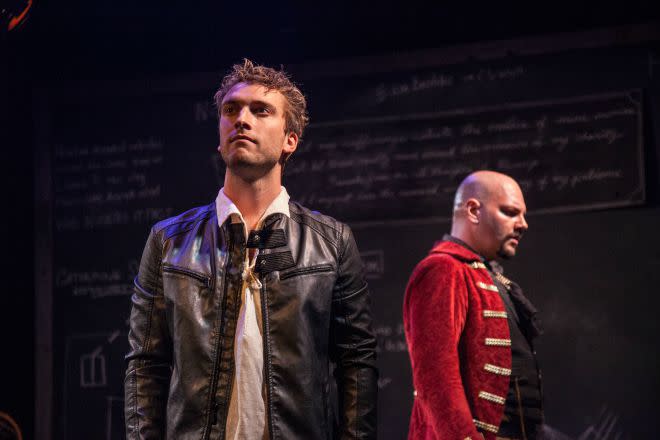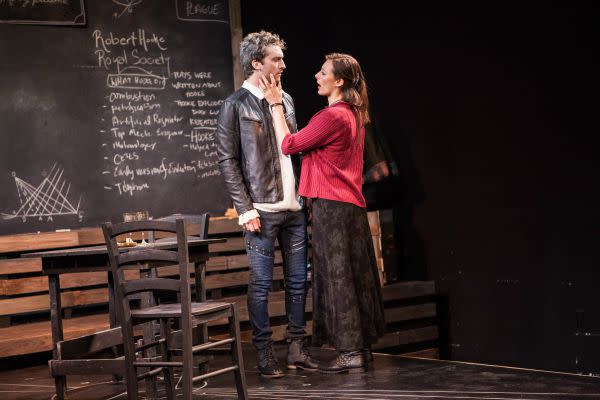Urbanite Theatre's Isaac's Eye

By Kay Kipling
Although Isaac Newton was a genius with many scientific accomplishments, to many, nearly 300 years after his death, his name will summon up one thing: an apple’s fall leading him to define the law of gravity. Still, that’s more than most of us will know of his contemporary and sometime rival, Robert Hooke. Who’s that, you might say?
Well, in Lucas Hnath’s play Isaac’s Eye, now onstage at Urbanite Theatre, we learn some things about both men. But we know from the outset that not everything in the play is true; our narrator (Tony Stopperan), tells us so, and proceeds throughout the evening to mark everything that is actually true on the huge chalkboard that dominates Seth Graham’s set. The rest exists in the mind of the playwright—although, rather like with the play Amadeus, which embroidered the relationship between composers Mozart and Salieri, once you’ve seen and heard the imagined stories, it’s hard to not sort of believe in them.
Hnath’s play posits that around 1665, the 20-something Isaac (Ben Williamson)—an undeniably bright, somewhat arrogant young upstart who probably belonged somewhere on the autism spectrum—wanted badly to become a member of the Royal Society. So, he asks an apothecary’s daughter he knows, Catherine Storer (Kim Stephenson), who wants to marry Isaac, to write to slight acquaintance Hooke, a prominent member who happens to be working on some of the same thoughts and experiments as Newton.
Isaac’s assumption is that Hooke will immediately recognize his brilliance and have him admitted. But not so fast; Hooke (Robby May) has motivations of his own, and he may be out to crush Newton rather than crusade on his behalf.

Catherine is ultimately caught between them, as is an unfortunate outsider (let’s call him Sam, as Stopperan, who plays him, suggests) suffering from the pesky plague that haunted the London area at that time. Tensions come to a head when Hooke insists that Isaac perform an experiment he claims to have already done: To prove that light is made of particles, he must stick a needle in his own eye (actually, tear duct) to see what it does to the colors in the light. (That Newton did that at one point is one of the truths noted on the chalkboard.)
Hnath’s play is full of interesting ideas, tossed back and forth chiefly between Hooke and Newton, and it’s given humor and an edge by the contemporary language often spoken, reinforced in some cases by the costumes by Becky Leigh. (Isaac, wearing blue jeans with studs and zippers and a leather jacket, comes off as part rock star, while Hooke wears clothing more suited to the period.) It’s also about the choices that people make in their lives, whether genius or not, about where work and love fit into their lives, and which takes priority.
Under the direction of Vincent Carlson-Brown, the cast succeeds in conveying the piece’s conflicts and drama; all are excellent, and I was never bored even when discussions got more technical. I was, however, sometimes uncomfortable, as the placement of some of the audience’s seats (including mine) forces one to look upward and sometimes directly into the bright stage lights. Not as excruciating as having a needle inserted into the eye, but something of a problem with a two-hour-plus running time.
However, the play and the production definitely warrant a viewing. Isaac’s Eye continues through Sept. 6; for tickets call 321-1397 or go to urbanitetheatre.com.



